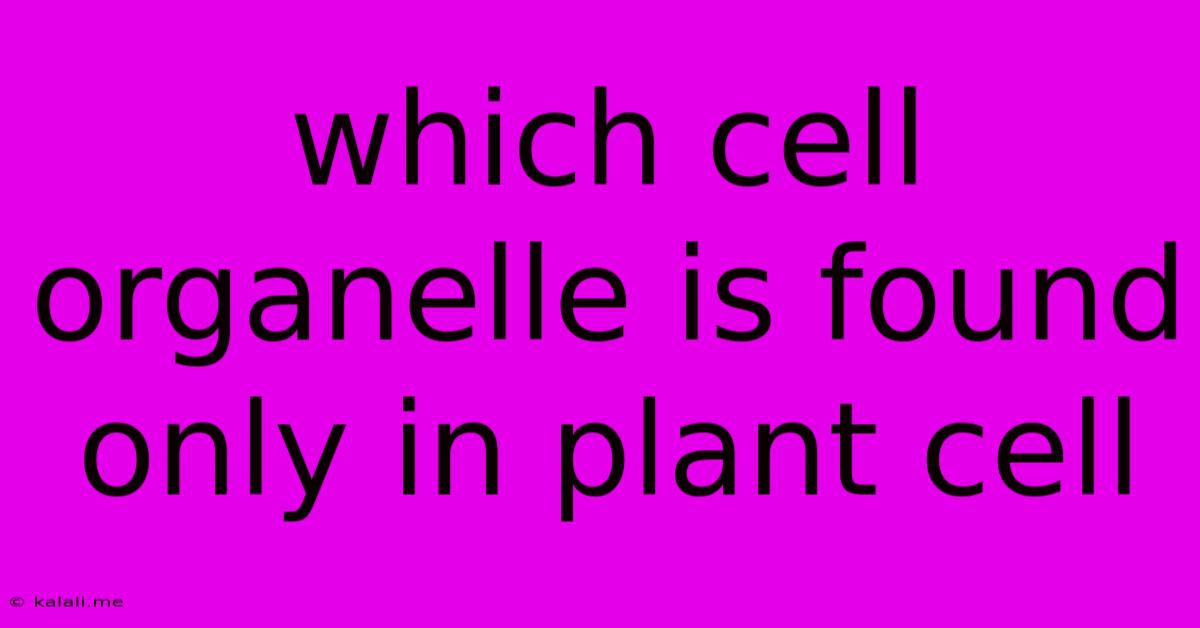Which Cell Organelle Is Found Only In Plant Cell
Kalali
Jun 13, 2025 · 3 min read

Table of Contents
Which Cell Organelle is Found Only in Plant Cells? The Unique Role of Chloroplasts
This article will explore the defining characteristic that sets plant cells apart from animal cells: the presence of chloroplasts. We'll delve into their structure, function, and the crucial role they play in the plant's life cycle and the broader ecosystem. Understanding chloroplasts is key to understanding the fundamental differences between plant and animal cells and the processes that sustain life on Earth.
What are Chloroplasts?
Chloroplasts are membrane-bound organelles found exclusively in plant cells and some protists. They are the sites of photosynthesis, the remarkable process where light energy is converted into chemical energy in the form of glucose. This energy fuels the plant's growth, development, and all other cellular processes. Think of them as the plant's solar power plants, converting sunlight into the food the plant needs to survive. This is what sets plant cells apart and allows them to be autotrophic, meaning they can produce their own food.
Structure of a Chloroplast
Understanding the structure of a chloroplast helps us appreciate its function. Key features include:
- Outer and Inner Membranes: These membranes regulate the passage of substances into and out of the chloroplast.
- Stroma: This is the fluid-filled space within the inner membrane, containing enzymes and other molecules necessary for photosynthesis.
- Thylakoids: These are flattened, membrane-bound sacs arranged in stacks called grana. The thylakoid membranes are where the light-dependent reactions of photosynthesis take place. This is where chlorophyll, the green pigment responsible for absorbing light energy, resides.
- Grana: These stacks of thylakoids maximize surface area for light absorption, increasing the efficiency of photosynthesis.
- DNA and Ribosomes: Chloroplasts contain their own DNA and ribosomes, remnants of their endosymbiotic origins. This suggests they were once independent organisms that formed a symbiotic relationship with early eukaryotic cells.
The Process of Photosynthesis
Photosynthesis, the process conducted within the chloroplasts, can be broadly divided into two stages:
- Light-dependent reactions: These occur in the thylakoid membranes, harnessing light energy to create ATP (adenosine triphosphate) and NADPH (nicotinamide adenine dinucleotide phosphate), energy-carrying molecules. Water is split during this process, releasing oxygen as a byproduct – the oxygen we breathe!
- Light-independent reactions (Calvin Cycle): These take place in the stroma, using the ATP and NADPH produced in the light-dependent reactions to convert carbon dioxide into glucose. This glucose serves as the plant's primary source of energy and building block for other organic molecules.
Why are Chloroplasts Important?
The importance of chloroplasts extends beyond the individual plant. Their role in photosynthesis is fundamental to:
- Oxygen Production: Photosynthesis is the primary source of oxygen in the Earth's atmosphere, making it essential for the survival of aerobic organisms, including humans.
- Food Chain: Plants are the base of most food chains. The energy produced through photosynthesis is transferred to herbivores and then to carnivores, sustaining the entire ecosystem.
- Carbon Dioxide Regulation: Plants absorb carbon dioxide from the atmosphere during photosynthesis, playing a critical role in regulating the Earth's climate.
In conclusion, the chloroplast is the unique cell organelle found only in plant cells (and some protists). Its crucial role in photosynthesis is fundamental to life on Earth, providing oxygen, regulating the climate, and forming the base of most food chains. Understanding its structure and function is essential for appreciating the complexity and interconnectedness of the biological world.
Latest Posts
Latest Posts
-
How Many Feet Are In One Fathom
Jun 13, 2025
-
Person Who Looks On The Dark Side
Jun 13, 2025
-
First 12 Elements On The Periodic Table
Jun 13, 2025
-
What Planet Has The Fastest Revolution
Jun 13, 2025
-
Least Common Multiple Of 10 And 9
Jun 13, 2025
Related Post
Thank you for visiting our website which covers about Which Cell Organelle Is Found Only In Plant Cell . We hope the information provided has been useful to you. Feel free to contact us if you have any questions or need further assistance. See you next time and don't miss to bookmark.